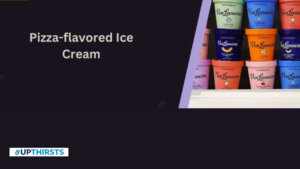19 Weird Ice Cream Flavors [2024’s Scoop on Strange]
Introduction
Ice cream, a delightful frozen treat enjoyed by people of all ages, has evolved from its humble beginnings to become a global sensation. The origins of this delectable dessert can be traced back to ancient China, where a concoction of rice and milk was frozen in the snow to create an early form of ice cream( weird pop tart flavors ) Over the centuries, the recipe traveled across continents and underwent various transformations, with each culture adding its unique touch. However, in the 17th century, ice cream gained widespread popularity in Europe, thanks to the ingenuity of Italian chefs who refined the recipe and introduced it to the aristocracy.
As time progressed, ice cream became more accessible to the general public, with vendors selling the frozen delight on the streets of cities worldwide. The 19th century saw significant advancements in ice cream production, as the invention of the hand-cranked ice cream maker made it easier for households to prepare this treat at home. The Industrial Revolution further revolutionized the ice cream industry, with the mass production of ice cream becoming a reality. This marked the beginning of an era where ice cream transitioned from a luxury enjoyed by the elite to a beloved treat for people from all walks of life.
The variety of flavors and toppings that characterize modern ice cream parlors is a testament to the creative genius of chefs and the diverse palates of consumers. Classic flavors such as vanilla, chocolate, and strawberry hold a special place in the hearts of ice cream enthusiasts. Still, frozen desserts have expanded far beyond these traditional choices. Unique and exotic flavors, such as lavender honey, matcha green tea, and salted caramel, provide a culinary adventure for those seeking a more adventurous palate.
The experience of indulging in a scoop of ice cream extends beyond just taste; it encompasses the rich texture and creamy consistency that define this frozen delight. The perfect scoop strikes a delicate balance between velvety smooth and refreshingly icy, creating a sensation tantalizing the taste buds with each spoonful. Whether served in a classic cone, a cup or sandwiched between two cookies in the form of an ice cream sandwich, the presentation of this frozen confection adds an extra layer of enjoyment to the overall experience.
In recent years, the ice cream industry has witnessed a surge in demand for healthier and more inclusive options. As dietary preferences evolve, so does the variety of ice cream alternatives. Plant-based ice creams, made from ingredients like almond milk, coconut milk, or soy milk, cater to the growing number of individuals adopting vegan or lactose-free lifestyles. Moreover, artisanal and small-batch ice cream makers have gained popularity, focusing on using high-quality, locally sourced ingredients to create unique and premium flavors that stand out in a saturated market.
The cultural significance of ice cream extends beyond its taste and texture; it is intertwined with moments of joy, celebration, and nostalgia. Ice cream parlors serve as gathering places for families and friends to share laughter and create lasting memories. Enjoying an ice cream cone on a hot summer day or savoring a sundae to mark a special occasion has become a universal tradition that transcends borders and cultural differences. In many societies, ice cream is not merely a dessert but a symbol of happiness and togetherness.
Ice cream has also found its way into popular culture, becoming a subject of fascination in literature, music, and cinema. Iconic scenes featuring characters enjoying ice cream cones or sharing an ice cream sundae have become enduring images that capture the essence of simple pleasures. From the jingle of an ice cream truck on suburban streets to the colorful displays of gelato in bustling city markets, the presence of ice cream in daily life is a testament to its enduring appeal.
The economic impact of the ice cream industry is substantial, with countless businesses dedicated to its production, distribution, and retail. Ice cream parlors, both large chains and independent establishments, contribute to local economies and provide employment opportunities. The global market for ice cream continues to expand, driven by innovation in flavors, packaging, and marketing strategies. As technology advances, how consumers access and enjoy ice cream has also evolved, with online ordering, delivery services, and specialty ice cream shops gaining prominence.
In conclusion, ice cream, with its rich history and diverse array of flavors, holds a special place in the hearts and palates of people around the world. From its ancient origins to today, ice cream has transcended cultural boundaries, evolving into a symbol of joy, togetherness, and indulgence. Whether enjoyed in the comfort of one’s home, at a local ice cream parlor, or a festive celebration, the experience of savoring this frozen delight is a timeless pleasure that continues to bring smiles to faces and create cherished moments for generations to come.
Indulging in a scoop of vanilla or chocolate seems almost passé when you enter the eccentric universe of ice cream. Brace yourself for a frozen rollercoaster ride through the uncharted territories of taste, as we unveil the 19 weirdest ice cream flavors that defy all norms. From savory surprises to mind-boggling mash-ups, these frozen concoctions are not just desserts – they’re edible adventures that challenge your palate and redefine the very essence of ice cream. Get ready to embark on a flavorful journey where every scoop tells a tale, and where the unexpected becomes the new norm. Discover the avant-garde world of frozen delights that will leave you questioning everything you thought you knew about this beloved treat.
“Savory Symphony: When Ice Cream Meets the Unusual” Prepare to tantalize your taste buds with unexpected savory notes that turn the traditional notion of sweet ice cream on its head. From bacon-infused wonders to tangy cheese blends, these flavors take the savory route to redefine your ice cream experience.
Let’s take a twisty ride through the vast universe of frozen delicacies! There’s no denying our outright love affair with ice cream–those ever-familiar flavors like chocolate, vanilla, and strawberry have become etched in our hearts over time we’ve got a scoopful of comfort waiting at the end of a cone. But as our gastronomic horizons expand wider than ever, we’re starting to see some truly weird ice cream flavors taking center stage.
From mouthwatering turkey to fiery hot sriracha, these icy oddities redefine the way we treat our taste buds. It’s time to dig in and unearth some frozen creations that will deeply challenge your idea of what belongs in ice cream, and possibly even entice you into taking a bite! So let’s brace our culinary spirit for a journey to the wild side as we delve into an eccentric world of ice cream beyond your wildest dreams.

Also Read: Best Tillamook Ice Cream Flavors
19 Weird Ice Cream Flavors of 2024
Ice cream is an undeniably beloved dessert worldwide, soothing our tongues on hot summer days, and cheering us up when we’re down. But beyond the classic, well-known favorites like chocolate and vanilla, a whole realm of weird and wacky ice cream flavors exists that are far from mundane and usual! From pizza to pickles, these novel flavors serve as a testament to human creativity in the culinary world and our ceaseless exploration for new taste sensations.

1. Thanksgiving Dinner from The Ice Cream Store
As you might have guessed from its name, this unique flavor serves all the delight of a Thanksgiving feast, but with an icy twist! Upon the first spoonful, you’ll be greeted with a burst of cranberry, morphing into tender turkey and savory stuffing. The sweet-salty contrast keeps your taste buds guessing and wanting more. You might even find bits of sweet potato and delectable roasted vegetables mixed in for a fully-rounded feast. As unusual as it may sound, this ice cream takes the essence of a family gathering and weaves it into a strangely addictive flavor that will leave you yearning for seconds.

2. Pizza-flavored Ice Cream
To all the Pizza enthusiasts who can’t get enough of that cheesy, saucy goodness – this one’s for you! Pizza-flavored ice cream is the ultimate blend of two of America’s favorite foods. With tomato, basil, oregano, and garlic folded into a rich, creamy base, every lick delivers an unfamiliar sensation akin to biting into a slice of pizza; yet, it’s undeniably ice cream. And yes, it may take a few tries to fall in love with it, but once you do, there’s no going back! Each scoop allows you to explore both the realms of traditional and innovative food craftsmanship, making for an unforgettable experience.

3. Cicada Ice Cream
When the delightful harmony of sweet and creamy meets the unmistakable crunch of insects, you get Cicada Ice Cream. Sound unsettling? Hang on a bit! In many parts of the world, eating insects is common practice. Cicadas, when blanched and coated in brown sugar and chocolate, mesh surprisingly well with the creamy ice cream base. The first taste might be startling, but some adventurous foodies report a distinct nutty flavor that is rather enjoyable. So if you’re someone who boldly accepts gastronomic challenges, Cicada Ice Cream can be a unique culinary adventure you might wish to embark on.

4. “Horse Flesh” Ice Cream
Horse Flesh Ice Cream, despite its undeniably shocking name, is a trendy flavor in Japan and no, it doesn’t contain any horse flesh. Instead, this ice cream gets its surprising richness from a soy-based sauce that mimics the umami flavor of horse meat. The rich, savory flavor is a far cry from the sweet, creamy ice cream we’re accustomed to, but for those who love breaking norms, Horse Flesh Ice Cream is worth a dip. It is a one-of-a-kind flavor that inspires curiosity and dares you to explore new taste boundaries.

5. Strawberry Balsamic from Sweet Action Ice Cream
The name “Strawberry Balsamic” might sound more like a salad dressing to you. But, this ice cream flavor from Sweet Action Ice Cream will sweep you off your feet. The vibrancy of strawberries superbly matches with the tangy notes of balsamic vinegar to create a sweet yet acidic flavor profile. With each bite, you can taste the tartness of the balsamic vinegar, followed by the sweetness of the strawberries, for a pleasant contrast on your palate. If you’re looking to explore strange yet delightful ice cream flavors, Strawberry Balsamic is worth considering.

6. Chili Peppermint Ice Cream
Just by hearing its name, you can imagine the flavorful whirlwind of Chili Peppermint Ice Cream. On the one hand, it presents the chilling freshness of peppermint. On the other, it offers a scorching array of chilies that stings the back of your throat. Together, these flavors work surprisingly well. The initial lick is a frosty blast, followed by the creeping sensation of spice that warms you from the inside. It might feel like a challenge eating it, but the flavor offers a unique thrill that can be quite addicting.

7. Foie Gras Ice Cream
The luxury item that once got its fame in restaurants has now made its appearance in the dessert world- Foie Gras Ice Cream. The idea of mixing the rich and buttery taste of foie gras with ice cream may sound unusual, but the result is a creamy marvel that’s likely to leave you licking your lips. The ice cream carries a unique savoriness, but don’t be fooled, it also brings out an unexpected sweetness. If you want to indulge in some luxury on a cone, Foie Gras Ice Cream is worth a shot.

8. Pink Lemonade Pop Rocks from Max & Mina’s Ice Cream
The dreamy nostalgia of pop rocks meets the frosty delight of pink lemonade to create a zesty, bubbly masterpiece. The zing of Pink Lemonade is punctuated by the surprising crackle from Pop Rocks, providing memorable bursts of fun in every icy scoop. The fun element of pop rocks mixed with the tangy flavor of pink lemonade creates an exciting combination that’s just as enjoyable for adults as it is for children. If you’re looking for a flavor that screams ‘summer fun’, Pink Lemonade Pop Rocks is a sure winner.

Also Read: Best Peppermint Ice Cream Brands
9. Spicy Sriracha Ice Cream
If you’re fond of spicy food, you’ll be all over this one – Spicy Sriracha Ice Cream. Here’s a flavor that kicks the classic, sweet notes of vanilla ice cream up a notch. The initial taste is sweet and creamy, then the sriracha kicks in, bringing a wave of heat that slowly builds up. It’s a beautiful balance of sweet creaminess and fiery spice, and it’s a rollercoaster of flavors you’re sure to remember. This ice cream is not for the faint of heart, but if you’re always up for a spicy challenge, this is a dish you won’t want to pass up.

10. Goat Cheese with Red Cherries from Jeni’s Splendid Ice Creams
When it comes to unusual ice cream flavors, Goat Cheese with Red Cherries from Jeni’s Splendid Ice Creams definitely raises some eyebrows. Cheese in ice cream is not a new concept, but goat cheese elevates the creaminess and adds a surprisingly pleasant tang to every bite. The tartness of the red cherries beautifully complements the rich, creamy goat cheese. If you have a penchant for creatively combining savory and sweet, this flavor will surely take your taste buds on a thrilling voyage.

11. Lobster Ice Cream
If you thought sea critters belonged only in savory meals, you’re in for a shock with Lobster Ice Cream. This innovative flavor shifts a beloved seafood from dinner plates to dessert bowls. With chunks of fresh lobster meat swirled into a creamy ice cream base, this dish offers an unusual blend of sweet and saline. Unconventional? Yes. Delicious? Absolutely. If you thought seafood could never be a dessert, Lobster Ice Cream is here to prove you wrong.

12. Glowing Jellyfish Protein-infused Vanilla Ice Cream
Time to dim the lights and cherish the perplexing allure of Glowing Jellyfish Protein-infused Vanilla Ice Cream. This ice cream not only titillates your taste buds but also delights your visual senses with its radiant blue glow. The infusion of specific proteins derived from jellyfish into a basic vanilla base offers no extraordinary taste. However, it’s the glow that steals the show. Indulging in this luminescent dessert looks nothing short of diving into the alluring depths of an enchanted ocean.

13. Extra Virgin Olive Oil from Odd Fellows Ice Cream
Extra Virgin Olive Oil from Odd Fellows Ice Cream seamlessly bridges the gap between the savory world and the dessert realm. Combining a rich, fragrant extra virgin olive oil with a smooth and creamy ice cream base, this flavor creates a taste sensation that is both bizarre and exceptional. The olive oil gives the ice cream a delightfully smooth texture and a subtle, fruity taste, for an extravagantly luxurious experience packed in a scoop.

14. Cheetos Flamin’ Hot Ice Cream
Cheetos Flamin’ Hot Ice cream is one of those weird ice cream flavors that takes your afternoon snack to a whole new level. Combining the heat of Flamin’ Hot Cheetos and the creamy sweetness of ice cream brings together the best of both worlds – hot and cold, sweet and spicy, snack and dessert. It’s just the sort of odd mix that could become legendary in snack food history.

15. Sweet Avocado Cayenne from Rococo Creamery
Sweet Avocado Cayenne from Rococo Creamery will take you on a gastronomic adventure. The buttery goodness of avocado laced with the heat from cayenne creates a tantalizing ice cream flavor. Furthermore, the subtle sweetness balances beautifully with the hot and creamy combination. This ice cream is sure to entice those looking to try a unique twist on a sweet treat.

16. Oyster Ice Cream
Diving into the exceptional yet enticing world of seafood-ice cream combination, enter Oyster Ice Cream. It’s a daring flavor unique for its inclusion of marine delicacies. This semi-sweet treat is creamy, briny, and carries a hint of the sea. Truly, it’s the closest one could get to enjoying the ocean on a sundae. It might sound wildly paradoxical, yet this exciting fusion nicely brings together the icy dessert and the ocean’s freshness.

17. Vanilla with Sweet Sriracha Sauce from Mason’s Creamery
Aside from the usual caramel or chocolate drizzles, we now have the Vanilla with Sweet Sriracha Sauce from Mason’s Creamery. This blend effectively plays with your palate, bringing the heat into the cold creamy vanilla. The Sriracha sauce draped over the ice cream encapsulates an exciting clash of sweet, creamy, and spicy notes. It’s a bold choice not meant for the faint-hearted, but those who dare to indulge are gulp for an intense flavor ride.

18. Pickle Ice Cream
Pickle Ice Cream seems to be an unexpected twist to the classic ice cream flavors, yet somehow it works. The sourness of pickles and the sugary sweetness of ice cream spin together an unexpected blend that’s strangely satisfying. This fascinating merger is enchanting in its own unique way, providing a sensory journey that swings between tangy, sweet, and slightly salty. It’s quirky, it’s playful, and stumbling upon this flavor might just tickle your fancy.

19. Gold Nugget from Coppa
Presenting an opulent dessert experience, let’s talk about the Gold Nugget from Coppa. This isn’t your average scoop of ice cream. This extravagant dessert made with imported Italian gold leaf and French Perigord truffle is every bit as luxurious as it sounds. The truffle lends a one-of-a-kind flavor that’s indulgent and sophisticated, while the gold leaves create an irresistible sparkly aesthetic. For those looking for a scoop of luxury, this is an ice cream flavor that you have to try.

Why Trying Weird Ice Cream Flavors Can Be a Fun Experience?
As for most of us, our first ice cream encounters were likely the classic flavors – vanilla, chocolate, strawberry. But now, imagine slurping down a scoop of sweet, creamy cicada or digging into a vibrant scoop of lobster. Weird? Absolutely. Fun? Certainly. Here’s why trying these unorthodox dessert ‘delights’ could be a joyride.
Excites Your Taste Buds
Diving into weird ice cream flavors is like embarking on a thrilling journey for your taste buds. Each bite could be a surprising blend of sweet, salty, tangy, or even spicy. Take the ‘Sweet Avocado Cayenne’ from Rococo Creamery for example, it’s a captivating roller coaster for the palate.
Unconventional can be Delicious
Often, novel flavors taste more complex than traditional ones, providing an entirely new dessert experience. The ‘Pie as in Cow,‘ aka ‘Horse Flesh’ ice cream from Japan’s Vanilla Food Company, manages to blend sweet and savory in each lick, gourmands swear by it!
Conversation Starter
And let’s not ignore the perfect conversation starter it turns out to be. Sharing your adventurous culinary exploits with others is simply fun. Imagine the reactions when you reveal that you tried ‘Foie Gras’ ice cream!
Food Adventure
Explore the wildest ends of the flavor spectrum and feel like an intrepid food adventurer. As they say ‘Variety is the spice of life!’ and these outlandish flavors sure add a new level of zesty entertainment into your otherwise plain scoop.
So, why not take the plunge and add some thrill to your dessert experience? It’s time to break free from the norm and redefine fun with these weird ice cream flavors.
Why Some Exotic Flavors Become a Hit While Others Don’t?
Weird ice cream flavors often hinge on sea-saw of success and failure, but ever wondered what makes some hit the jackpot while others slump in disappointment?
Suitability to the Format
Firstly, the success of a variant depends heavily on its suitability to the ‘ice cream’ format. Rich and cream-based flavors tend to work well with the medium. ‘Goat Cheese with Red Cherries‘ from Jeni’s Splendid Ice Creams, for instance, is a hit because of its creamy consistency and the tart cherry contrast.
Balance in Flavor
Maintaining a balance in flavor, is also crucial. For instance, the ‘Extra Virgin Olive Oil‘ ice cream from OddFellows curates a delightful balance with its sweetness complementing the fruitiness of the olive oil.
Novelty Vs Usability
Often the shock factor can earn brownie points. The amazing ‘Glowing jellyfish protein-infused Vanilla‘ ice cream certainly grabs attention with its glow-in-the-dark gimmick. But longevity is a different ball game altogether. A flavor that seems too strange or challenging might attract attention initially but can fail to accumulate a regular consumer base. Hence, the novelty factor has to balance out with usability for the long run.
Cultural and Regional Preferences
Regional and cultural preferences also play a significant role. A flavor that’s popular in Japan, like the ‘Horse Flesh‘ ice cream might not resonate well with Western consumers.
So, while it is fascinating to churn-out crazy ice cream flavors, achieving the right equilibrium of taste, texture, and acceptability is vital for a flavor to be a hit. Thus, not all exotic ice cream flavors manage to endure the test of taste buds and consumers alike. The key rests in providing a unique, yet satisfying eating experience that customers would want to revisit.
Also Read: Best Jeni’s Ice Cream Flavors
Frequently Asked Questions
What are some of the weirdest ice cream flavors in the world?
Some of the weirdest ice cream flavors you can find include Thanksgiving Dinner, Pizza, Cicada, Horse Flesh, Strawberry Balsamic, Chili Peppermint, Foie Gras, and even Lobster and Oyster.
Is weird ice cream safe to eat?
Absolutely! As strange as these flavors may sound, they are produced with edible ingredients and pass necessary food safety standards.
Where can I find weird ice cream flavors?
Many of these flavors are unique to specific ice cream shops and regions. For instance, Horse Flesh ice cream is a rarity found only in Japan.
Does weird ice cream have a big following?
While these eccentric flavors represent a niche market, there’s a growing trend toward adventurous eating, and these unique ice creams are becoming increasingly popular.
Will there be more weird ice cream flavors in the future?
The ice cream world thrives on innovation, you never know what strange yet tantalizing flavor might churn up next!
Are all weird ice cream flavors savory?
Interestingly no, there is a mix. From strawberry balsamic to goat cheese with red cherries, these flavors span the gamut from savory to sweet.
Can I make my own weird ice cream flavors at home?
With the right ingredients and a good ice cream maker, the sky’s the limit! You can experiment with your own crazy concoctions.
Do these weird flavors actually taste good?
Taste is subjective and varies from person to person. Some people absolutely enjoy the daring blend of unfamiliar tastes, while others prefer the traditional flavors.
Are any of these weird ice cream flavors vegan?
It would depend on the specific flavor and ingredients used. Many ice cream shops offer vegan versions of their unique flavors.
Can I order these weird ice cream flavors online?
Depending on the ice cream parlor and their shipping policies, you may be able to order these crazy flavors right to your doorstep.
What are the 4 major types of desserts?
- Baked desserts.
- Frozen desserts.
- Dessert drinks.
- Cold desserts.
- Fried desserts.
- Puddings and custards.
- Cobblers.
Conclusion
In a world that never ceases to surprise us, it’s only fitting that we’d find such a thrillingly bizarre array of ice cream flavors. While some of these flavors may initially provoke a shudder of disbelief, they underscore the beauty of culinary innovation and our inherent desire to experiment and push boundaries. Unusual? Absolutely! Unappetizing? Not quite. Most of these weird ice cream flavors have found their own niche following, proving that when it comes to ice cream, there’s something enduringly delightful about discovering new tastes and textures that venture far beyond the ordinary scoop.
Whether you are an adventurous foodie or a comfort food connoisseur, these offbeat ice cream flavors open a Pandora’s box of tantalizing thrills and spills. Who knows? You might just find your new favorite among these curious concoctions. Until then, keep that spoon ready and your mind open, because in the world of ice cream, anything is tantalizingly possible!
In conclusion, water is an indispensable and irreplaceable element, playing a pivotal role in sustaining life and shaping our world. Its versatility is unparalleled, serving as the essence of survival, a catalyst for growth, and a force of transformation. From the microscopic realms to the grandeur of oceans and rivers, water weaves through the fabric of our existence, leaving an indelible mark on the planet.
The significance of water extends beyond its biological necessity, reaching into the realms of culture, spirituality, and human history. Its calming presence has inspired poets, artists, and thinkers throughout the ages, evoking a sense of awe and reverence. Moreover, water has been a silent witness to the rise and fall of civilizations, a testament to its enduring power to shape landscapes and narratives.
Ecologically, water plays a critical role in maintaining the delicate balance of ecosystems. It nurtures diverse habitats, supporting a myriad of flora and fauna. Yet, this fragile equilibrium is constantly threatened by human activities, emphasizing the urgent need for responsible stewardship and conservation efforts.
In all its forms – liquid, solid, and gas – water showcases the marvels of nature’s adaptive processes. The water cycle, a perpetual dance of evaporation, condensation, and precipitation, illustrates the interconnectedness of the Earth’s systems. Understanding and appreciating this cycle is paramount in addressing contemporary challenges such as climate change and water scarcity.
Access to clean and safe water is a fundamental right on a human scale, yet it remains a pressing global issue. Billions still need more reliable access to potable water, leading to dire consequences for health, sanitation, and overall well-being. As we navigate the 21st century, ensuring equitable access to water resources becomes a moral imperative and an essential aspect of sustainable development.
Innovation and technology are instrumental in addressing water-related challenges. Advancements in water purification, desalination, and efficient water use contribute to the ongoing quest for water security. Moreover, harnessing the power of water for renewable energy sources, such as hydro power, highlights its potential as a sustainable ally in pursuing a greener future.
The discourse around water prompts us to adopt a holistic perspective, recognizing its interconnectedness with global issues like biodiversity loss, climate change, and social justice. As we ponder the profound implications of water scarcity, pollution, and unequal access, we must collectively work towards comprehensive solutions that prioritize the health of our ecosystems and the well-being of communities worldwide.
Water is more than a life-sustaining substance; it is a profound force that shapes the world’s landscapes, fuels our collective imagination, and connects all living beings. As stewards of this precious resource, we must cherish, protect, and manage water wisely, ensuring its abundance for current and future generations. The story of water continues to unfold, and our role in shaping its narrative will determine the sustainability and resilience of our planet.
In conclusion, the world of juices is a vibrant and ever-evolving landscape that caters to diverse palates, health-conscious consumers, and culinary enthusiasts alike. From the refreshing simplicity of natural fruit juices to the innovative blends that grace the shelves, the variety and versatility within juices reflect a broader cultural and dietary shift towards wellness and indulgence.
Freshly squeezed and commercially produced juices have become an integral part of modern lifestyles, offering a convenient and flavorful way to consume essential nutrients. The market’s response to evolving consumer preferences has led to the emergence of cold-pressed juices, superfood blends, and functional beverages, catering to individuals seeking hydration and additional health benefits.
The health and wellness trend has undeniably influenced the juice industry, with an increasing emphasis on natural ingredients, reduced sugar content, and the incorporation of superfoods. This shift aligns with a broader nutrition awareness, with consumers actively seeking products contributing to their overall well-being. As a result, the juice market has become a dynamic space, encouraging innovation and the exploration of new flavor profiles.
However, navigating this flavorful landscape with a critical eye is essential. While juices can be a valuable source of vitamins and antioxidants, they can pose challenges, particularly when laden with added sugars or lacking the fiber inherent in whole fruits. As consumers, making informed choices about our juices is crucial to maintaining a balanced and nutritious diet.
The popularity of DIY (Do It Yourself) juices has also surged, with individuals investing in juicers and blenders to create personalized concoctions at home. This trend empowers consumers to experiment with flavors and fosters a deeper connection to the ingredients they consume. It reflects a desire for transparency in food choices and a return to the roots of natural, unprocessed nourishment.
The global fascination with juices extends beyond their nutritional value. Juices are cultural symbols deeply embedded in traditions, rituals, and celebrations across the globe. From the rich heritage of freshly squeezed citrus juices in Mediterranean cultures to the vibrant street markets offering exotic tropical blends in Asia, juices are woven into the fabric of culinary diversity.
While the juice industry flourishes, it has challenges. Sustainability concerns have emerged, such as the environmental impact of packaging and production processes. As consumers become more eco-conscious, the industry is prompted to explore sustainable practices, including recyclable packaging, responsible sourcing of ingredients, and waste reduction initiatives.
In conclusion, the world of juices is a testament to the dynamic interplay between taste, health, and cultural significance. As consumers, embracing a balanced approach to incorporating juices into our diets ensures that we savor the flavors and the myriad benefits they offer. Whether it’s a revitalizing morning smoothie, an exotic fruit blend, or a simple glass of freshly squeezed orange juice, our choices contribute to our evolving narrative of juices. In this ever-expanding market, let us savor the richness, embrace the variety, and toast to the kaleidoscope of flavors that juices bring to our tables and glasses.
In conclusion, “Upthirst” encapsulates a sense of elevation, a rising desire for more, and an upward surge of enthusiasm. Though the term may not have a widely recognized definition, its implications suggest a positive and aspirational mindset. As we reflect on the “Upthirst” concept, it prompts us to explore the innate human inclination towards growth, improvement, and an unquenchable thirst for progress.
“Upthirst” aligns with the universal human spirit that constantly seeks to elevate itself personally and collectively. It resonates with the pursuit of knowledge, the ambition to achieve goals, and the tenacity to overcome challenges. In essence, “Upthirst” symbolizes the upward trajectory that individuals and societies embark upon in their quest for self-improvement and fulfillment.
On an individual level, the concept of “Upthirst” encourages introspection and self-discovery. It invites us to recognize and embrace our innate desire for personal growth, urging us to set goals, challenge ourselves, and strive for continuous improvement. Whether it’s advancing in our careers, nurturing relationships, or cultivating new skills, “Upthirst” encourages a proactive approach to life’s journey.
Moreover, “Upthirst” holds relevance in the context of societal progress. It aligns with the collective pursuit of innovation, education, and social change. Societies with a shared “Upthirst” ethos are likelier to foster environments that support learning, diversity, and inclusivity. It fuels the community’s momentum to address challenges, adapt to changing circumstances, and advance toward a better future.
The concept also finds resonance in the professional realm. Organizations that embrace a culture of “Upthirst” are more likely to be innovative, adaptive, and forward-thinking. Employees within such environments are encouraged to seek knowledge, propose novel ideas, and contribute to the continuous improvement of the workplace. The result is a dynamic and thriving organizational culture that mirrors the upward momentum encapsulated by “Upthirst.”
In the larger context of global challenges, “Upthirst” becomes a powerful catalyst for addressing issues such as sustainability, social inequality, and environmental stewardship. It fuels the collective determination to overcome obstacles, implement positive changes, and strive for a more equitable and sustainable world.
While “Upthirst” may not have a predefined definition, its interpretive flexibility is its strength. It serves as a motivational beacon, guiding individuals and communities toward a mindset of progress and improvement. It prompts us not to settle for the status quo but to continually seek ways to ascend, learn, and contribute to improving ourselves and the world around us.
Essentially, “Upthirst” is a rallying call to embrace the inherent human desire for growth and progress. It challenges us to set our sights higher, strive for excellence, and maintain an unyielding thirst for improvement in every facet of our lives. As we incorporate the spirit of “Upthirst” into our personal and collective endeavors, we embark on a journey of continuous elevation, propelled by the unwavering belief that there is always more to explore, achieve, and become.
In conclusion, the story of milk is of remarkable significance, encompassing cultural, nutritional, and economic dimensions that have shaped societies across the globe. Beyond its nutritional richness, milk carries profound cultural symbolism, often symbolizing nurturing, sustenance, and community. From the pastoral landscapes where dairy farming thrives to the kitchens where it transforms into myriad products, milk is a versatile and essential ingredient in the human experience.
Nutritionally, milk is a powerhouse of essential nutrients, providing a rich source of calcium, protein, vitamins, and minerals crucial for bone health, growth, and overall well-being. It is pivotal in early childhood development, offering a foundation for healthy bones and teeth. The diverse milk-based products, from cheese to yogurt, further extend its nutritional impact, contributing to culinary traditions worldwide.
Culturally, milk is sacred in many societies, often intertwined with rituals, symbolism, and religious practices. It has been a symbol of purity, fertility, and abundance in various mythologies and belief systems. Sharing a glass of milk is not merely a culinary gesture but a communal one, fostering bonds within families and communities.
Economically, the dairy industry is a cornerstone of agriculture, providing livelihoods for millions and contributing significantly to global economies. However, the industry also faces challenges, including concerns about sustainability, animal welfare, and the environmental impact of large-scale dairy farming. As we navigate the complex landscape of milk production, it becomes imperative to seek sustainable and ethical practices that balance economic viability with environmental and social responsibility.
The increasing popularity of plant-based milk alternatives in recent years adds a new dimension to the narrative of milk. Options like almond, soy, and oat milk cater to diverse dietary preferences, lactose intolerance, and ethical considerations. This shift reflects a broader awareness of environmental sustainability and a desire for a more inclusive approach to meeting nutritional needs.
The story of milk is not without controversy, and debates surrounding issues such as raw milk consumption, industrial farming practices, and ethical treatment of dairy animals underscore the complexity of the dairy industry. Striking a balance between meeting the global demand for dairy products and addressing these concerns remains an ongoing challenge that requires collaboration, innovation, and a commitment to responsible agricultural practices.
In health and wellness trends, milk continues to be scrutinized for its potential impact on human health. While its nutritional benefits are well-established, discussions about lactose intolerance, dairy allergies, and the role of saturated fats in whole milk contribute to a nuanced conversation about individual dietary choices and overall health outcomes.
In conclusion, milk is not just a beverage; it is a narrative that weaves through the fabric of human history, touching upon health, culture, economics, and ethics. Whether enjoyed in its pure form, transformed into diverse dairy products, or replaced by plant-based alternatives, the story of milk reflects our ever-evolving relationship with food, health, and the planet. As we navigate the complexities of the dairy industry, it is crucial to approach the story of milk with an informed perspective, embracing its nutritional benefits and the imperative to foster a sustainable, inclusive, and ethical future for this foundational ingredient in our lives.
In conclusion, the world of drinks is an expansive and diverse terrain, encompassing myriad flavors, cultural traditions, and social rituals that enrich the human experience. From the simplicity of water to the complexity of crafted cocktails, beverages play a multifaceted role in our lives, offering hydration, pleasure, and a canvas for social connection.
The significance of drinks goes beyond mere sustenance, intertwining with the fabric of our cultures and societies. Whether it’s the ceremonial tea traditions in East Asia, the friendliness of sharing a cup of coffee in European cafes, or the festive toasts of celebrations worldwide, drinks serve as conduits for social interaction, fostering connections and creating shared moments of joy.
Hydration, a fundamental aspect of well-being, finds its most straightforward form in water. Water’s vital role in maintaining bodily functions, supporting health, and regulating temperature cannot be overstated. As we navigate a world filled with various beverage choices, it’s essential to recognize the foundational importance of water in promoting overall wellness.
The rise of diverse and innovative beverages reflects the dynamic nature of consumer preferences and the ever-evolving culinary landscape. Artisanal coffees, specialty teas, fresh fruit juices, and craft beers have become expressions of taste, identity, and lifestyle. The advent of mixology has elevated the creation of cocktails to an art form, showcasing the creative fusion of flavors and techniques.
Cultural and regional identities are often deeply intertwined with specific drinks. From the rich history of wine-making in European vineyards to the centuries-old tea ceremonies of Japan, beverages carry the essence of traditions, reflecting the unique flavors and rituals passed down through generations. Exploring these cultural beverages provides a taste of diverse flavors and offers a glimpse into the heritage and stories of different communities.
However, as we savor the vast world of beverages, we must approach consumption with mindfulness. The impact of sugary drinks on health, the environmental footprint of beverage production, and the ethical considerations surrounding sourcing ingredients demand a conscientious approach. Striking a balance between indulgence and responsible consumption ensures that our enjoyment of drinks aligns with broader values of health, sustainability, and ethical stewardship.
In the contemporary era, the beverage industry has witnessed a surge in the popularity of non-alcoholic alternatives, reflecting a growing awareness of health-conscious choices and the desire for inclusive social spaces. This shift underscores the importance of offering diverse and appealing options that cater to various preferences and lifestyles.
In conclusion, the world of drinks is a rich tapestry woven with threads of flavor, culture, and social connection. Whether it’s a simple glass of water, a culturally significant tea ceremony, or a sophisticated cocktail, each sip contributes to the broader narrative of our lives. As consumers, embracing a mindful and diverse approach to beverages allows us to savor the richness of global flavors, celebrate cultural traditions, and foster connections in the shared experience of enjoying drinks. In this vast and ever-expanding landscape, let us raise our glasses in celebration and appreciation of the diverse and meaningful stories that drinks bring to our tables and gatherings.
In conclusion, the world of beverages is a tapestry woven with a rich array of flavors, cultural traditions, and social rituals that make them integral to the human experience. From the simplicity of water to the complexity of artisanal concoctions, beverages are more than just thirst-quenchers; they are conduits for culture, connection, and the celebration of life.
The significance of beverages transcends their mere function of hydration. They are carriers of cultural heritage, embodying centuries-old traditions and practices. Whether it’s the tea ceremonies of East Asia, the coffee rituals of the Middle East, or the wine-making traditions of Europe, beverages are vessels through which societies express their identity, values, and stories.
Hydration, a fundamental human need, is embodied in beverages, and water remains the purest and most essential form of sustenance. As we explore the vast landscape of beverages, it is crucial to acknowledge the foundational role of water in maintaining health, regulating bodily functions, and sustaining life itself.
The evolution of the beverage landscape reflects the dynamic interplay between consumer preferences, culinary innovation, and cultural exchange. The rise of craft beverages, specialty teas, artisanal coffees, and inventive cocktails mirrors the global quest for unique flavors and experiences. This diversity not only tantalizes the taste buds but also fosters a sense of exploration and discovery.
Cultural and regional identities are deeply entwined with specific beverages, each sip representing a journey through history, geography, and tradition. Exploring these cultural libations is not merely a gustatory adventure but a profound dive into the heritage and customs of diverse communities. The stories behind beverages add layers of meaning to drinking, turning it into a sensory and intellectual experience.
As we celebrate the diversity of beverages, we must approach consumption with mindfulness. The impact of sugary drinks on health, the environmental footprint of beverage production, and the ethical considerations surrounding sourcing demand a conscious approach. Striking a balance between indulgence and responsible consumption ensures that our enjoyment of beverages aligns with broader values of health, sustainability, and ethical stewardship.
The beverage industry’s response to evolving consumer demands has seen a surge in non-alcoholic alternatives, reflecting a societal shift towards healthier choices and inclusive spaces. This trend emphasizes the industry’s adaptability and responsiveness to changing cultural attitudes and its commitment to offering diverse and appealing options.
In conclusion, beverages are not mere liquids that quench our thirst but vessels of culture, history, and social connection. Whether shared over a family dinner, served in a traditional ceremony, or enjoyed in a trendy café, beverages play a central role in shaping the moments we cherish. As consumers, embracing a mindful and diverse approach to beverages allows us to engage with the world in a sip-by-sip exploration of flavors, cultures, and shared stories. In this vast and dynamic landscape, let us raise our glasses in celebration and appreciation of the diverse and meaningful narratives that beverages bring to our tables and lives. Cheers to the richness of each beverage’s experiences and to the countless moments yet to be savored on this flavorful journey.
In conclusion, the concept of liquid transcends its physical state to embody a profound metaphor for fluidity, adaptability, and the essence of life itself. As a fundamental state of matter, liquids play a crucial role in the natural world, serving as the medium for diverse chemical and biological processes. Beyond its scientific significance, the term “liquid” extends into the realms of metaphor, symbolism, and cultural significance, offering a lens through which we can explore existence’s dynamic and ever-changing nature.
In the scientific context, liquids represent a state of matter characterized by the ability to flow and take the shape of their container. Water, a universal solvent, exemplifies the essential role of liquids in facilitating life processes, supporting ecosystems, and shaping the geological features of our planet. Understanding the behavior of liquids is integral to fields ranging from physics and chemistry to biology and environmental science.
Metaphorically, the concept of liquidity speaks to the adaptable and transformative nature of life. In facing challenges, uncertainties, and changing circumstances, individuals and societies must be fluid, resilient, and open to continuous adaptation. The metaphorical liquidity of life encourages an approach that embraces change, values versatility, and navigates the unpredictable currents with grace.
Symbolically, liquids hold cultural and spiritual significance across diverse traditions. Water, in particular, features prominently in rituals, ceremonies, and cleansing practices. Its purifying qualities and associations with rebirth symbolize renewal, spiritual transformation, and the cyclical nature of existence. From holy water in religious ceremonies to the ceremonial pouring of libations, liquids serve as conduits for cultural expressions and rites.
Liquids’ cultural and symbolic importance extends to beverages, elixirs, and potions, each carrying a unique narrative and sensory experience. From the communal act of sharing a cup of tea to the celebratory clinking of glasses in toasts, liquids become vessels for social connection, tradition, and the expression of shared moments. The variety of beverages reflects the diversity of human cultures, offering a taste of different traditions and histories with each sip.
In the contemporary context, the term “liquid” finds resonance in financial and economic discussions, where assets that can be quickly converted into cash are often referred to as liquid assets. The symbolic association between liquidity and financial health underscores the interconnectedness between the fluidity of resources and the stability of economic systems.
In conclusion, liquid encapsulates a dynamic interplay between life’s scientific, metaphorical, and symbolic dimensions. As a state of matter, liquids are fundamental to the functioning of our natural world. Metaphorically, the fluidity of life invites us to embrace change, adaptability, and resilience. Symbolically, liquids hold cultural, spiritual, and social significance, shaping rituals, traditions, and the fabric of human connections.
Whether contemplating the scientific principles governing liquids, reflecting on the symbolic lessons they offer, or participating in the cultural rituals they inspire, the concept of liquid becomes a multifaceted lens through which we can explore the beauty and complexity of existence. In recognizing the dynamic nature of liquids, we gain insights into the physical world and the essence of being alive – an ever-changing, flowing, and interconnected journey through the currents of life.
In conclusion, coffee is not only a globally cherished beverage but a cultural phenomenon that transcends borders, bringing people together in the shared ritual of savoring its rich flavors. From the bustling coffeehouses of Europe to the traditional coffee ceremonies in Ethiopia, coffee has woven itself into the fabric of human social interaction, creativity, and daily routines.
At its essence, coffee represents more than just a stimulating brew; it symbolizes a universal language, uniting individuals across diverse cultures and lifestyles. The aroma of freshly ground beans and the comforting warmth of a well-brewed cup creates an atmosphere conducive to conversation, contemplation, and camaraderie. Coffeehouses, whether the historic cafes of Paris or the trendy specialty coffee shops of Brooklyn, serve as communal spaces where people gather, connect, and engage in the vibrant tapestry of social life.
The journey of coffee from bean to cup mirrors the intricate web of global trade, agriculture, and craftsmanship. Coffee-producing regions, often situated in lush equatorial climates, contribute not only to the world’s supply of beans but also play a significant role in shaping the livelihoods of countless communities. With its intricate supply chains and dedication to quality, the coffee industry reflects a commitment to sustainable practices, fair trade, and the preservation of diverse coffee varieties.
Culturally, coffee rituals vary widely, uniquely expressing the beverage’s significance. In Italy, the espresso is a swift and intense experience reflective of a fast-paced lifestyle. In Turkey, coffee is prepared in elaborate ceremonies, and in Scandinavia, the “fika” tradition encourages taking breaks to enjoy coffee and pastries, emphasizing the value of relaxation and social connection.
The sensory journey of coffee involves taste, aroma, texture, and visual appeal. From the velvety crema atop an espresso to the intricate latte art designs, coffee becomes an art form that engages multiple senses. The connoisseurship of coffee has given rise to a burgeoning specialty coffee movement, where enthusiasts and professionals alike delve into the intricacies of bean origins, brewing methods, and flavor profiles, elevating coffee appreciation to new heights.
Beyond its cultural and sensory dimensions, coffee has been linked to creativity, productivity, and social innovation. The coffeehouse culture of the Enlightenment era served as a meeting place for thinkers, artists, and writers, fostering intellectual exchange and the birth of influential ideas. Today, coffee shops remain spaces where people find inspiration, engage in work or study, and build creative communities.
While the global popularity of coffee is indisputable, the industry faces challenges related to sustainability, environmental impact, and fair labor practices. Ethical considerations, such as supporting shade-grown coffee, promoting biodiversity, and ensuring fair compensation for coffee farmers, are increasingly crucial aspects of the coffee conversation. As consumers become more conscientious, a growing emphasis is on making responsible choices considering the entire coffee supply chain.
In conclusion, coffee is more than a beverage; it is a dynamic cultural force permeating millions’ daily lives. Its journey from bean to cup intertwines with global trade, sustainable practices, and diverse artistic expressions. As we celebrate the rich tapestry of coffee culture, let us also recognize the importance of ethical choices that ensure the longevity of this beloved beverage. Whether enjoyed in solitude as a moment of personal reflection or shared in the convivial atmosphere of a coffeehouse, coffee remains a timeless companion in the human experience, stimulating not just our senses but the fabric of our social connections and cultural traditions.
In conclusion, tea, a beverage with a history spanning millennia, is more than just a drink; it is a cultural touchstone, a symbol of hospitality, and a conduit for mindfulness and connection. From the serene tea ceremonies of Japan to the bustling chai stalls of India, tea has ingrained itself into the fabric of human societies, leaving an indelible mark on rituals, traditions, and daily life.
The global prevalence of tea underscores its universal appeal, offering a diverse array of flavors, aromas, and rituals that vary across continents and cultures. Whether it’s the delicate nuances of a traditional Chinese green tea, the robust richness of a British black tea, or the aromatic spices of an Indian chai, tea reflects the geographical diversity of its origins and the creative adaptation of its preparation methods.
Culturally, tea has become synonymous with moments of reflection, contemplation, and social bonding. The tea ceremony, a cornerstone of Japanese culture, is a meditative practice that elevates preparing and drinking tea into an art form. In England, the afternoon tea tradition serves as a delightful occasion for conversation and indulgence, while in Morocco, the elaborate pouring of mint tea is a gesture of hospitality and friendship.
Beyond its cultural significance, tea has woven itself into the tapestry of daily life for millions worldwide. The morning ritual of sipping tea has become a universal experience, providing a gentle and comforting start to the day. Tea breaks, whether in the workplace or at home, offer respite, fostering a sense of calm amidst the hustle and bustle of modern life.
The health benefits associated with tea have also contributed to its enduring popularity. Green tea, in particular, is celebrated for its antioxidant properties and potential health-promoting effects. The herbal tea category, including varieties like chamomile and peppermint, is often sought after for its calming and soothing qualities. As consumers become more health-conscious, the demand for teas with specific wellness attributes grows.
The journey of tea from plant to cup involves meticulous cultivation, harvesting, and processing, reflecting the artistry and craftsmanship inherent in its production. The commitment to sustainable and ethical practices, such as organic farming and fair trade, is increasingly recognized as integral to ensuring the long-term viability of the tea industry.
Tea, however, has its challenges. The industry faces issues related to environmental sustainability, fair labor practices, and the impact of climate change on tea-producing regions. As global consumers become more attuned to these issues, a growing responsibility exists to support initiatives prioritizing the well-being of the environment and the communities involved in tea production.
In conclusion, tea is a timeless elixir that transcends its humble origins to become a cultural ambassador, a source of comfort, and a catalyst for connection. Its legacy encompasses a rich tapestry of traditions, ceremonies, and daily rituals that have shaped societies and communities. As we savor the myriad flavors and rituals of tea, let us also be mindful of its cultural heritage and our responsibility to preserve its authenticity and integrity. Whether enjoyed in solitude for moments of introspection or shared in the friendliness of social gatherings, tea remains a testament to the enduring beauty of simplicity and the profound impact of a single leaf in hot water.

